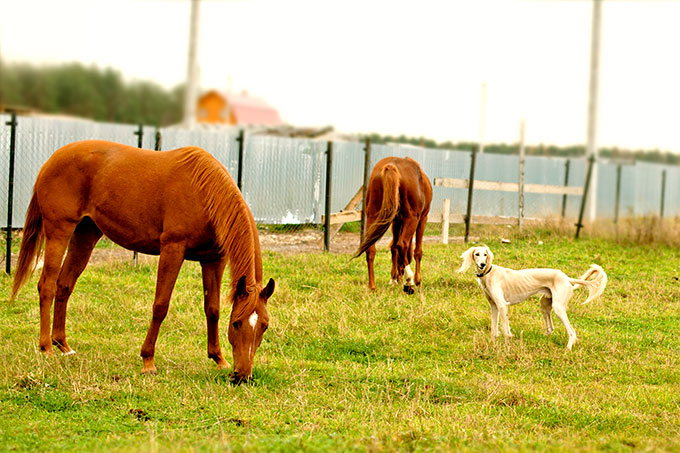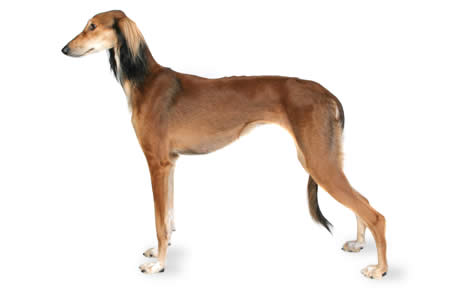One of the oldest of dog breeds, Salukis were once considered a gift from Allah. They’re fast as the wind, skinny as a supermodel, and quietly devoted to their people.
Even though these are purebred dogs, some may still end up in the care of shelters or rescues. Consider adoption if this is the breed for you.
A Saluki is easy to groom, challenging to train, and not to be trusted off leash. Not well-suited for apartment life or for being left home alone all day, these dogs need space to roam, preferably in a yard with a high fence, as they have a high prey drive and will wander if allowed. They’d also fair better with an experienced pet parent who can stay firm and consistent with training while providing them with the exercise they need. Give your Saluki the love and care they crave, and you’ll have a loyal, lifelong companion.
DogTime recommends this big, spacious crate to give your big Saluki a place to rest and relax. You should also pick up this dog fetch toy to help burn off your pup’s high energy!
See below for complete list of Saluki characteristics!
Saluki Dog Breed Pictures
Adaptability
-
Adapts Well To Apartment Living
Looking for the best dog for your apartment? Contrary to popular belief, the suitability of dogs who adapt well to apartment living goes beyond its size. Apartment dwellers have a myriad of dog breeds to choose from as potential companions, with various factors to consider. Some large breeds can adapt well to apartment living and have lower activity levels. Others may require more space and possess higher energy levels. On the other hand, certain small dog breeds with abundant energy can still find contentment with indoor playtime or brisk walks.
However, when selecting a dog that adapts well apartments, it is essential to prioritize your neighbors. Opting for a pet that doesn’t excessively bark and behaves politely when encountering others in shared spaces like is crucial for maintaining a harmonious apartment environment.
In high-rise settings, it’s worth noting that numerous small dogs may exhibit a propensity for high energy and frequent barking. This makes them less suitable for apartment living. Therefore, desirable qualities in an apartment dog encompass being quiet, low-energy, and displaying polite behavior towards other residents.
Factors To Consider When Choosing A Dog For An Apartment
When considering dogs that adapt well to apartments, size alone should not be the sole determinant. Apartment dwellers have a wealth of dog breeds to choose from as potential furry companions. It’s important to remember that the size of your living space is just one factor to consider. While some larger breeds can adapt well to apartment living, with lower, others may require more space and have higher energy levels, making them less suitable for smaller apartments. Conversely, certain small dog breeds with higher energy levels can still thrive in apartments, finding contentment through indoor playtime or brisk walks. However, it is crucial to consider your neighbors’ comfort when selecting a dog. Opt for a pet that doesn’t bark excessively and behaves politely when interacting with others in shared spaces.
Therefore, it’s important to prioritize qualities such as being quiet, low-energy, calm indoors, and exhibiting good manners when living in close proximity to other residents. By considering these factors, you can find a dog that will adapt well to apartment living and create a harmonious living environment for everyone involved.
-
Good For Novice Owners
Some dogs are simply easier than others; they take to training better and are fairly easygoing. They’re also resilient enough to bounce back from your mistakes or inconsistencies.
Dogs who are highly sensitive, independent thinking, or assertive may be harder for a first-time dog parent to manage. You’ll get your best match if you take your dog-owning experience into account as you choose your new pooch.
If you’re new to dog parenting, take a look at 101 Dog Tricks and read up on how to train your dog!
-
Sensitivity Level
Some dogs will let a stern reprimand roll off their backs, while others take even a dirty look to heart. Low-sensitivity dogs, also called “easygoing,” “tolerant,” “resilient,” and even “thick-skinned,” can better handle a noisy, chaotic household, a louder or more assertive owner, and an inconsistent or variable routine. Do you have young kids, throw lots of dinner parties, play in a garage band, or lead a hectic life? Go with a low-sensitivity dog.
-
Tolerates Being Alone
Some breeds bond very closely with their family and are more prone to worry or even panic when left alone by their owner. An anxious dog can be very destructive–barking, whining, chewing, and otherwise causing mayhem. These breeds do best when a family member is home during the day or if you can take the dog to work.
-
Tolerates Cold Weather
Breeds with very short coats and little or no undercoat or body fat, such as Greyhounds, are vulnerable to the cold. Dogs with a low cold tolerance need to live inside in cool climates and should have a jacket or sweater for chilly walks. You can find a great jacket for your dog here!
-
Tolerates Hot Weather
Dogs with thick, double coats are more vulnerable to overheating. So are breeds with short noses, like Bulldogs or Pugs, since they can’t pant as well to cool themselves off. If you want a heat-sensitive breed, your dog will need to stay indoors with you on warm or humid days, and you’ll need to be extra cautious about exercising your dog in the heat.
All-around friendliness
-
Affectionate With Family
When it comes to unconditional love and unwavering loyalty, few animals can rival the affectionate nature of dogs. These remarkable creatures have earned their reputation as man’s best friend, and many breeds are particularly renowned for their love and devotion to their families. With their warm hearts and wagging tails, affectionate family dogs enrich the lives of their owners in countless ways.
One such breed known for its affectionate demeanor is the Golden Retriever. With their gentle temperament and friendly disposition, Golden Retrievers form deep bonds with their families. They eagerly participate in family activities, whether it’s a game of fetch in the yard or cuddling on the couch during a movie night. Their expressive eyes and ever-wagging tails are a testament to the joy they feel in the presence of their loved ones.
Another family-favorite breed is the Labrador Retriever. Renowned for their playful and patient nature, Labradors are excellent companions for children and adults alike. They readily engage in playtime with the kids, showcasing their boundless energy and enthusiasm. But when the day winds down, they seamlessly transition into loving and gentle cuddle buddies, comforting their family members with their warm presence.
Beyond specific breeds, mixed-breed dogs also have a special place in the hearts of families seeking affectionate companions. The shelter dogs, in particular, form deep connections with their adoptive families. They seem to understand the second chance they’ve been given and repay it with endless love and gratitude.
How To Know If A Dog Is Good With Families
The affectionate nature of family dogs extends beyond play and cuddles. Dogs have a remarkable ability to sense their owner’s emotions, offering comfort and support during difficult times. Whether it’s a wagging tail after a long day at work or a sympathetic nuzzle during moments of sadness, they prove time and again that they are attuned to their family’s needs.
It is important to note that not all dogs of the same breed will be equally affectionate. Some dogs may be more independent or aloof, while others may be more clingy or demanding of attention. The best way to find out how affectionate a dog is is to meet them in person and interact with them.
-
Kid-Friendly
Being gentle with children, sturdy enough to handle the heavy-handed pets and hugs they can dish out, and having a blasé attitude toward running, screaming children are all traits that make a kid-friendly dog. You may be surprised by who’s on that list: Fierce-looking Boxers are considered good with children, as are American Staffordshire Terriers (which are considered Pit Bulls). Small, delicate, and potentially snappy dogs such as Chihuahuas aren’t always so family-friendly.
**All dogs are individuals. Our ratings are generalizations, and they’re not a guarantee of how any breed or individual dog will behave. Dogs from any breed can be good with children based on their past experiences, training on how to get along with kids, and personality. No matter what the breed or breed type, all dogs have strong jaws, sharp pointy teeth, and may bite in stressful circumstances. Young children and dogs of any breed should always be supervised by an adult and never left alone together, period.
-
Dog Friendly
Friendliness toward dogs and friendliness toward humans are two completely different things. Some dogs may attack or try to dominate other dogs, even if they’re love-bugs with people; others would rather play than fight; and some will turn tail and run. Breed isn’t the only factor. Dogs who lived with their littermates and mother until at least six to eight weeks of age and who spent lots of time playing with other dogs during puppyhood, are more likely to have good canine social skills.
-
Friendly Toward Strangers
Stranger-friendly dogs will greet guests with wagging tails and nuzzles; others are shy, indifferent, or even aggressive. However, no matter what the breed, a dog who was socialized and exposed to lots of different types, ages, sizes, and shapes of people as a puppy will respond better to strangers as an adult. Remember that even friendly dogs should stay on a good, strong leash like this one in public!
Health And Grooming Needs
-
Amount Of Shedding
If you’re going to share your home with a dog, you’ll need to deal with some level of dog hair on your clothes and in your house. However, shedding does vary greatly among the breeds. Some dogs shed year-round, some “blow” seasonally, some do both, and some shed hardly at all. If you’re a neatnik, you’ll need to either pick a low-shedding breed or relax your standards. To help keep your home a little cleaner, you can find a great de-shedding tool here!
-
Drooling Potential
Drool-prone dogs may drape ropes of slobber on your arm and leave big, wet spots on your clothes when they come over to say hello. If you’ve got a laid-back attitude toward slobber, fine; but if you’re a neatnik, you may want to choose a dog who rates low in the drool department.
-
Easy To Groom
Some breeds are brush-and-go dogs; others require regular bathing, clipping, and other grooming just to stay clean and healthy. Consider whether you have the time and patience for a dog who needs a lot of grooming, or the money to pay someone else to do it.
-
General Health
Due to poor breeding practices, some breeds are prone to certain genetic health problems, such as hip dysplasia. This doesn’t mean that every dog of that breed will develop those diseases; it just means that they’re at an increased risk.
If you’re adopting a puppy, it’s a good idea to find out which genetic illnesses are common to the breed you’re interested in. You may also want to ask if your shelter or rescue has information about the physical health of your potential pup’s parents and other relatives.
-
Potential For Weight Gain
Some breeds have hearty appetites and tend to put on weight easily. As in humans, being overweight can cause health problems in dogs. If you pick a breed that’s prone to packing on pounds, you’ll need to limit treats, make sure they get enough exercise, and measure out their daily food servings into regular meals rather than leaving food out all the time.
Ask your vet about your dog’s diet and what they recommend for feeding your pooch to keep them at a healthy weight. Weight gain can lead to other health issues or worsen problems like arthritis.
-
Size
Get ready to meet the giants of the doggy world! Large dog breeds aren’t just big balls of fluff, they’re like loving, oversized teddy bears on a mission to steal your heart. Need some convincing? Let’s dive into the awesome benefits of owning one!
First things first, these pooches are a living security system! With their impressive size and thunderous barks, they’ll have any would-be intruder running for the hills. Talk about peace of mind! Plus, who needs an alarm when you’ve got a furry giant protecting your castle?
But that’s not all. Large dog breeds are all about loyalty and devotion. They’ll stick by your side through thick and thin, becoming your most dedicated bestie. Their love knows no bounds! When you have a giant fluffball showing you unconditional love, you’ll feel like the luckiest human on the planet.
Now, let’s talk about their talents. These big fellas are the ultimate working partners. With brains and brawn, they’re up for any challenge. From search and rescue missions to lending a helping paw to those in need, these dogs are superheroes in fur coats. They’ll make you proud every step of the way!
Don’t let their size fool you—these gentle giants have hearts as big as their paws. They’re incredible with kids and other pets, spreading their love like confetti. Their patience and kindness make them perfect family pets, ensuring harmony in your household.
Oh, and get ready to break a sweat! These dogs are fitness enthusiasts, and they’ll keep you on your toes. Daily walks, jogs, and play sessions will not only keep them happy and healthy but will also give you a reason to ditch the couch and join in on the fun. It’s a win-win situation!
So, if you’re ready for a dose of big love, go ahead and consider a large dog breed. They’re the best wing-dog you could ever ask for, ready to make your life a thousand times more exciting, loving, and downright awesome! Get ready for the big adventure of a lifetime!
Trainability
-
Easy To Train
Easy-to-train dogs are more adept at forming an association between a prompt (such as the word “sit”), an action (sitting), and a consequence (getting a treat) very quickly. Other dogs need more time, patience, and repetition during training.
Many breeds are intelligent but approach training with a “What’s in it for me?” attitude, in which case you’ll need to use rewards and games to teach them to want to comply with your requests.
Related:
10 Fun, Impressive Tricks You Can Teach Any Dog
-
Intelligence
Dogs who were bred for jobs that require decision making, intelligence, and concentration, such as herding livestock, need to exercise their brains, just as dogs who were bred to run all day need to exercise their bodies. If they don’t get the mental stimulation they need, they’ll make their own work–usually with projects you won’t like, such as digging and chewing. Obedience training and interactive dog toys are good ways to give a dog a brain workout, as are dog sports and careers, such as agility and search and rescue.
-
Potential For Mouthiness
Common in most breeds during puppyhood and in Retriever breeds at all ages, mouthiness means a tendency to nip, chew, and play-bite (a soft, fairly painless bite that doesn’t puncture the skin). Mouthy dogs are more likely to use their mouths to hold or “herd” their human family members, and they need training to learn that it’s fine to gnaw on chew toys, but not on people. Mouthy breeds tend to really enjoy a game of fetch, as well as a good chew on a toy that’s been stuffed with kibble and treats.
-
Prey Drive
Dogs with a high prey drive have an instinctive desire to stalk, capture, and prey upon potential food sources. Dogs who were bred to hunt, such as Terriers, have an inborn desire to chase — and sometimes kill — other animals. Anything whizzing by — such as cats, squirrels, and perhaps even cars — can trigger that instinct.
How to address a high prey drive
Off-leash adventures are too great a temptation for pups who will wander and hunt. Dogs who like to chase need to be leashed. And, even on a leash, you may experience your dog pulling on the leash to reach rodents or birds in their sight. Otherwise, these pups should be kept in a fenced area when outdoors. If your pup has a high prey drive, you’ll need a high, secure fence in your yard.
These breeds generally aren’t a good fit for homes with smaller pets that can look like prey, such as cats, hamsters, or small dogs. Breeds that were originally used for bird hunting, on the other hand, generally won’t chase, but you’ll probably have a hard time getting their attention when there are birds flying by.
Other behavioral concerns
Observing your dog’s prey drive, which is instinctual and biologically-rooted, is not the same as observing aggression. Much aggression is born of fear and anxiety, especially in the case of dog aggression toward humans.
The tendency to wander, even into oncoming traffic, can produce diasterious results for pups with predatory instincts. It can also lead to pups being bitten by snakes or attacked by other wild animals they may pursue while on the hunt.
-
Tendency To Bark Or Howl
Some breeds sound off more often than others. When choosing a breed, think about how often the dog vocalizes. Learn more about breeds with a tendency to bark or howl.
If you’re considering a hound, would you find their trademark howls musical or maddening? If you’re considering a watchdog, will a city full of suspicious “strangers” put your pup on permanent alert? Will the local wildlife literally drive your dog wild? Do you live in housing with noise restrictions? Do you have neighbors nearby? Then you may wish to choose a quieter dog.
-
Wanderlust Potential
Some breeds are more free-spirited than others. Nordic dogs such as Siberian Huskies were bred to range long distances, and given the chance, they’ll take off after anything that catches their interest. And many hounds simply must follow their noses–or that bunny that just ran across the path–even if it means leaving you behind.
Exercise needs
-
Energy Level
High-energy dogs are always ready and waiting for action. Originally bred to perform a canine job of some sort, such as retrieving game for hunters or herding livestock, they have the stamina to put in a full workday. They need a significant amount of exercise and mental stimulation, and they’re more likely to spend time jumping, playing, and investigating any new sights and smells.
Low-energy dogs are the canine equivalent of a couch potato, content to doze the day away. When picking a breed, consider your own activity level and lifestyle, and think about whether you’ll find a frisky, energetic dog invigorating or annoying.
-
Intensity
A vigorous dog may or may not have high energy, but everything they do, they do with vigor: they strain on the leash (until you train them not to), try to plow through obstacles, and even eats and drinks with great big gulps. These dynamos need lots of training to learn good manners, and may not be the best fit for a home with young kids or someone who’s elderly or frail. A low-vigor dog, on the other hand, has a more subdued approach to life.
-
Exercise Needs
Some breeds do fine with a slow evening stroll around the block. Others need daily, vigorous exercise, especially those that were originally bred for physically demanding jobs, like herding or hunting.
Without enough exercise, these breeds may put on weight and vent their pent-up energy in ways you don’t like, such as barking, chewing, and digging. Breeds that need a lot of exercise are good for outdoorsy, active people, or those interested in training their dog to compete in a high-energy dog sport, such as agility.
-
Potential For Playfulness
Some dogs are perpetual puppies — always begging for a game — while others are more serious and sedate. Although a playful pup sounds endearing, consider how many games of fetch or tag you want to play each day, and whether you have kids or other dogs who can stand in as playmates for the dog.
Saluki Overview
The Saluki’s origins are shrouded in the sands of time, but his history is believed to go back to antiquity. He is the very definition of grace and speed, well deserving of the name bestowed on him by his Arab breeders — The Noble. The Saluki is bred for speed, strength, and endurance, qualities that are evident in his long, narrow head and sleek yet muscular body.
Beautiful but reserved, the Saluki is affectionate without being overly demonstrative. He’s happy to prove his loyalty through quiet companionship. Not everyone is offered the gift of a Saluki’s devoted friendship, but those happy few who receive it are appreciative of the honor.
Salukis are widely admired for their exotic appearance, but not everyone is well suited to live with this spirited and independent hunter. Any movement, be it a squirrel, cat, or radio-controlled car, will activate the Saluki’s instinct to chase, and his speed has been clocked at 30 to 35 miles per hour.
Unless he’s protected by a strong human on the other end of the leash or a securely fenced yard, he’s likely to meet his end beneath the wheels of a car. You might think that Salukis living in the country would have fewer issues, but they’ve been known to chase down and tangle with or kill goats, otters, foxes, raccoons, snakes, squirrels, and deer.
To keep a Saluki safe and well exercised, provide him with 300 to 400 lateral feet of fenced area where he can run full out. If your yard isn’t that large, you should have easy access to a fenced park, an enclosed sports field at a school, or a beach with no nearby road. On leash, the Saluki makes an excellent jogging companion — if you can keep up with him. He’s also a good competitor in agility and lure coursing. Some Salukis participate in obedience and tracking as well.
Indoors, the Saluki will make himself at home on your soft sofa or bed. He likes his comforts and needs cushioning for his somewhat bony body. Using his long, skinny muzzle, he’ll surf your kitchen counters in search of anything edible.
The calm and gentle Saluki can become timid and shy without early socialization and regular reinforcement through new experiences and introductions to many different people throughout his life. Generally quiet but alert, he’s a good watchdog, but not a guard dog. Salukis are fearless in the hunt but otherwise unaggressive.
Training a Saluki is possible, but don’t expect the perfect obedience you might have from a Golden Retriever. Salukis think for themselves, and if something else is more interesting than what you’re asking them to do, they’re perfectly happy to ignore you. Use positive reinforcement techniques such as food rewards and praise, never harsh verbal or physical corrections.
Salukis can make excellent companions for older children, but they aren’t recommended for homes with young children. They’re tolerant, but young Salukis can be too active for children younger than 8 years of age, and their thin skin and knobby bones make them vulnerable to injury if children aren’t careful.
While Salukis aren’t overly demonstrative, they do become strongly attached to their people and dislike being left alone for long periods. Consider a Saluki if you have time to give to a devoted, graceful friend who can run like the wind.
Saluki Highlights
- Salukis love to run and need regular daily exercise.
- They must be kept on leash whenever they’re not in a securely fenced area. They have a strong prey drive and will pursue anything furry and in motion, heedless of their owner’s commands.
- Salukis are a reserved breed although they’re devoted to their people.
- Early and ongoing socialization is important for this breed to prevent shyness and skittishness.
- Salukis are not recommended for apartments. They require a large fenced yard where they can run safely. Underground electronic fencing is not recommended; their prey drive is so strong they’ll push past it.
- It is important to provide comfortable bedding for a Saluki since he doesn’t have enough body fat to provide padding.
- Salukis should not live outdoors. They thrive on human companionship and will become depressed if left alone for long periods.
- Although these dogs can make gentle and calm companions for older children, they are not recommended for homes with small children.
- Salukis are generally quiet dogs.
- When training a Saluki, be consistent, and use only positive reinforcement techniques such as food rewards and praise, since the breed is so sensitive.
- Salukis are fastidious and like to be clean. They shed little and require only weekly brushing.
- Salukis should not reside in homes that have small pets. Even with the best training, a Saluki will view small pets as prey and will try to hunt them.
- Salukis prefer the companionship of other Salukis, but they can get along with other dogs that do not have dominant natures.
- Salukis can be picky eaters.
- Never buy a Saluki from a puppy mill, a pet store, or a breeder who doesn’t provide health clearances or guarantees. Look for a reputable breeder who tests her breeding dogs to make sure they’re free of genetic diseases that they might pass onto the puppies and who breeds for sound temperaments.
Saluki History
Once known as the Persian Greyhound or the gazelle hound, the Saluki has long been considered one of the most ancient of breeds. Recent genetic evidence confirms this to be the case.
Scientists speculate that Salukis and other ancient breeds descend from the first dogs and made their way through the world with their nomadic owners. Depictions of dogs resembling Salukis — with a Greyhoundlike body and feathering on the ears, tail, and legs — appear on Egyptian tombs dating to 2100 B.C.E., some 4,000 years ago. Even older are carvings from the Sumerian empire (7,000-6,000 B.C.E.) that show dogs with a striking resemblance to the Saluki.
Pharaohs hunted gazelles and hares with Salukis, which often worked in partnership with falcons. The dogs were frequently honored with mummification after death. Nomadic Muslims, who generally despised dogs as unclean animals, considered Salukis a gift from Allah and referred to the dogs by the honorific El Hor, meaning The Noble.
Salukis were the only dogs permitted to sleep inside the tents. The breed may take its name from the ancient city of Saluk, in Yemen, or perhaps from the city of Seleukia in Syria. Another theory suggests that the name is a transliteration of the Arabic word for hound.
Salukis were widespread in the Middle East and could be found in Persia (modern-day Iran), Syria, Egypt, Palestine, Anatolia, Mesopotamia, and Arabia. The first documented case of Salukis arriving in Britain was in 1840, but it wasn’t until after World War I, when many British officers returned with them from the Middle East, that the breed became established in Great Britain.
Interest in the Saluki was slower to take hold in the United States. The Saluki Club of America was founded in 1927, the same year the breed was recognized by the American Kennel Club. The first Saluki registered by the AKC was Jinniyat of Grevel in 1929. Today the Saluki is a rare treasure, ranking 116th among the 155 breeds and varieties recognized by the AKC.
Saluki Size
Saluki males stand 23 to 28 inches at the shoulder; females are significantly smaller. Weight ranges from 35 to 70 pounds.
Saluki Personality
The Saluki is an aloof dog, but one who’s devoted to his family. He’s gentle and thrives on quiet companionship. He has a tendency to bond with a single person, which can lead to separation anxiety.
With strangers, Salukis are reserved, and they can be shy if they’re not socialized at an early age. Socialization should continue throughout their life. They generally get along with other dogs, but prefer other Salukis, or at least other sighthounds. They’re sensitive dogs and will pick up on and become stressed by tensions in the home.
Salukis love comfort and enjoy being pampered with soft bedding and access to furniture. Like cats, they’re fastidious about personal cleanliness.
Like every dog, Salukis need early socialization — exposure to many different people, sights, sounds, and experiences — when they’re young. Socialization helps ensure that your Saluki puppy grows up to be a well-rounded dog.
Saluki Health
The Saluki is a hardy breed that does not suffer from many genetically inherited diseases. The following problems may be seen in Salukis:
- Anesthesia Sensitivity: Because of their low level of body fat, sighthounds such as the Saluki have a reputation for being sensitive to anesthesia and certain other drugs. Fortunately, the new drugs available these days have properties that make sighthound reactions to drugs much less likely. In addition, most veterinarians are aware of the special anesthesia and drug needs of sighthounds, but it never hurts to confirm this awareness if you’re taking your Saluki to a new veterinarian.
- Hemangiosarcoma: This malignant cancer is found in the lining of blood vessels and the spleen.
- Cardiomyopathy: This disease of the heart muscle takes two forms: dilated and hypertrophic. Dilated cardiomyopathy (DCM) is the progressive enlargement of the ventricles, the heart’s main pumping chambers. Hypertrophic cardiomyopathy causes a drastic increase in heart muscle mass. DCM is the most common form of cardiomyopathy and tends to affect young to middle-aged males in larger breeds.
- Hypothyroidism: Hypothyroidism is an abnormally low level of the hormone produced by the thyroid gland. A mild sign of the disease may be infertility. More obvious signs include obesity, mental dullness, drooping of the eyelids, low energy levels, and irregular heat cycles. The dog’s fur becomes coarse and brittle and begins to fall out, while the skin becomes tough and dark. Hypothyroidism can be treated with daily medication, which must continue throughout the dog’s life. A dog receiving daily thyroid treatment can live a full and happy life.
If you’re buying a puppy, find a good breeder who will show you health clearances for both your puppy’s parents. Health clearances prove that a dog’s been tested for and cleared of a particular condition.
In Salukis, you should expect to see health clearances from the Orthopedic Foundation for Animals (OFA) for cardiac (heart) and thyroid disease.
Because some health problems don’t appear until a dog reaches full maturity, health clearances aren’t issued to dogs younger than 2 years old. Look for a breeder who doesn’t breed her dogs until they’re two or three years old.
Saluki Care
Salukis are not suited for apartment life. They need a home with a large, securely fenced yard where they can run flat out. The ideal running area for a Saluki is 300 to 400 feet in length or width. Fences should be at least five to six feet high or a Saluki will easily jump them. Underground electronic fencing will not contain a Saluki, nor will it protect him from other animals that might enter your yard.
Keep your Saluki on leash whenever he’s not in an enclosed area. A Saluki was bred for hunting and has a strong prey drive. If he sees anything fast and furry, he’ll pursuit it for as long as he can, disregarding any commands to come or stop.
Salukis are indoor dogs and require soft, cushioned bedding to prevent calluses from forming. Place food well out of reach of the Saluki’s inquiring nose. That means behind closed doors or up about seven feet.
Salukis are intelligent and learn quickly, but they’re also independent and can be stubborn, which makes training a challenge. To hold your Saluki’s attention, keep training sessions short, fun, and interesting. If a Saluki becomes bored, he will choose not to learn. Use positive reinforcement, never harsh verbal or physical corrections.
Saluki Feeding
Recommended daily amount: 1.75 to 2.75 cups of a high-quality dog food daily, divided into two meals.
How much your adult dog eats depends on his size, age, build, metabolism, and activity level. Dogs are individuals, just like people, and they don’t all need the same amount of food. It almost goes without saying that a highly active dog will need more than a couch potato dog.
The quality of dog food you buy also makes a difference — the better the dog food, the further it will go toward nourishing your dog and the less of it you’ll need to shake into your dog’s bowl.
Salukis are the supermodels of the dog world and can be picky eaters. Remember that they are supposed to look sleek, and you may just barely see the outline of their ribs beneath their skin.
For more on feeding your Saluki, see our guidelines for buying the right food, feeding your puppy, and feeding your adult dog.
Saluki Coat Color And Grooming
The Saluki has a short, smooth, silky body coat. The entire body can be smooth, or the Saluki can have slight feathering on the legs, the backs of the thighs and sometimes the shoulders, and the underside of the tail. The long ears are covered with silky hair.
Salukis come in white, cream, fawn, golden, grizzle and tan, black and tan, and tricolor (white, black, and tan). The pigmentation of the nose is black or liver.
Salukis are a clean, low-shedding breed with no doggy odor. Brush the coat weekly to remove dead hair and distribute skin oils. Comb feathering once or twice a week to remove tangles. A wipedown with a damp cloth is generally enough to keep your Saluki clean, so bathe him only if he’s dirty.
Other grooming needs include dental hygiene and nail care. Brush your Saluki’s teeth at least two or three times a week to remove tartar buildup and the accompanying bacteria. Daily is better.
Trim his nails once or twice a month, as needed. If you can hear the nail clicking on the floor, they’re too long. Short nails keep the feet in good condition and won’t scratch your legs when your Saluki jumps up to greet you.
Begin getting your Saluki used to being brushed and examined when he’s a puppy. Handle his paws frequently — dogs are touchy about their feet — and look inside his mouth and ears. Make grooming a positive experience filled with praise and rewards, and you’ll lay the groundwork for easy veterinary exams and other handling when he’s an adult.
Saluki Children And Other Pets
Salukis can make excellent companions for older children, but they aren’t recommended for homes with young children. They’re tolerant, but young Salukis can be too active for children younger than 8 years of age, and their thin skin and knobby bones make them vulnerable to injury if children aren’t careful.
They generally get along with other dogs, but prefer other Salukis, or at least other sighthounds. They won’t chase small dogs or cats in their own household, but other animals, such as pet birds, mice, rabbits, or hamsters could prove too much of a temptation.
Saluki Rescue Groups
Salukis are sometimes acquired without any clear understanding of what goes into owning one, and these dogs often end up in the care of rescue groups, in need of adoption or fostering. Other Salukis end up in rescue because their owners have divorced or died. If you’re interested in adopting an adult Saluki who’s already gone through the destructive puppy stage and may already be trained, a rescue group is a good place to start.
Saluki Dog Breed Pictures
-
Saluki Dog Breed Picture

-
Saluki Dog Breed Picture

-
9 Blackside

-
Saluki Dog Breed Picture
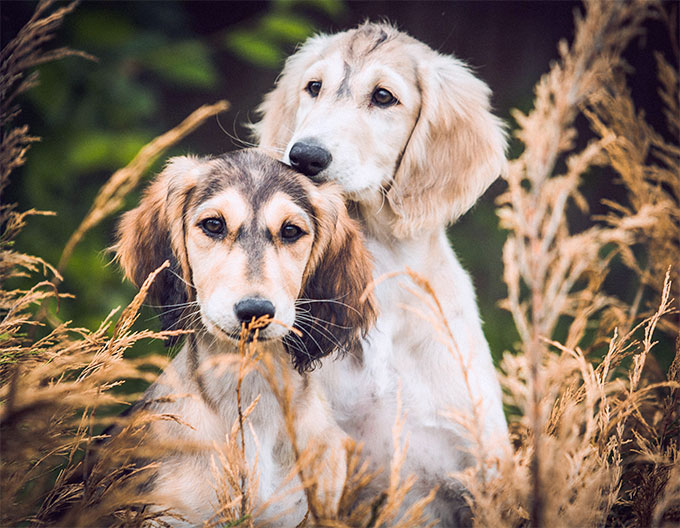
-
Saluki Dog Breed Picture
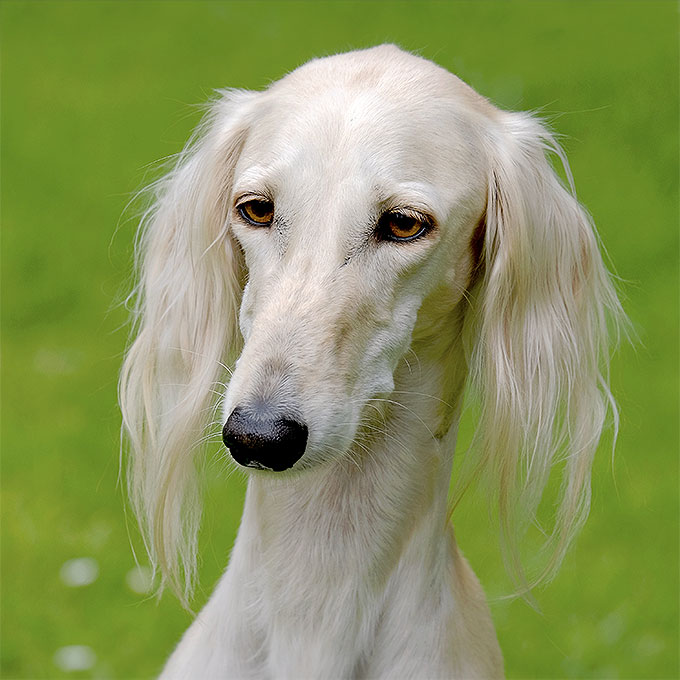
-
Saluki Dog Breed Picture
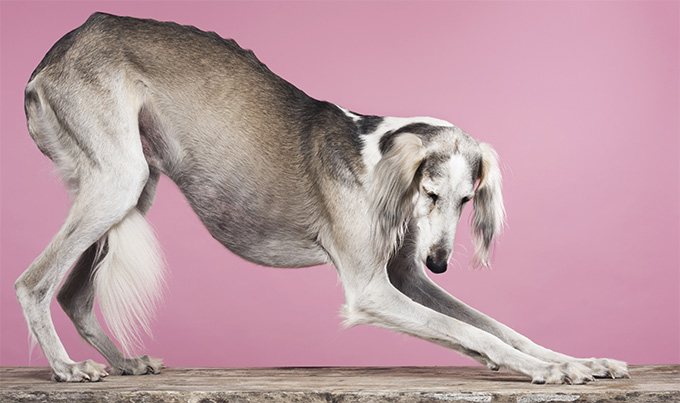
-
Saluki Dog Breed Picture
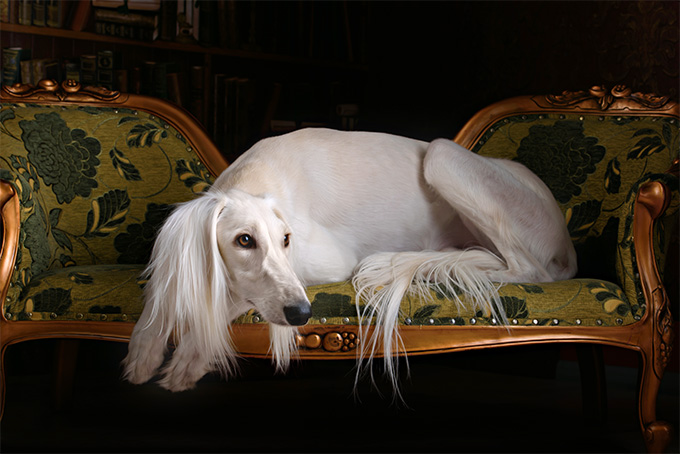
-
Saluki Dog Breed Picture
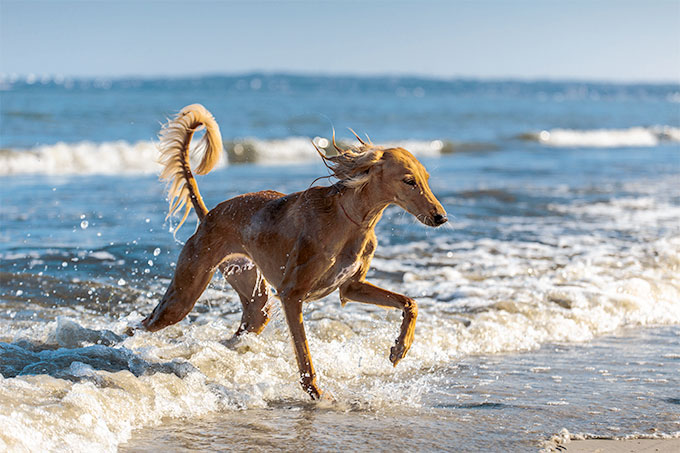
-
Saluki Dog Breed Picture

-
Saluki Dog Breed Picture
